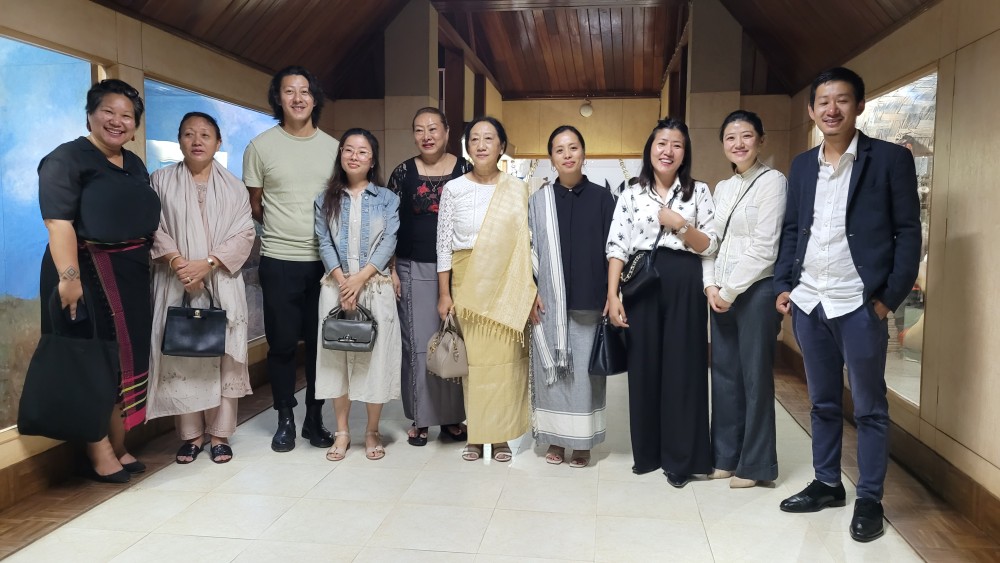Kaisa Rio and others with TakeOne production house team during the screening of documentary film ‘Where Cotton Flowers Grow’ in Kohima on September 18. (Morung Photo)

Our Correspondent
Kohima | September 19
A documentary film ‘Where Cotton Flowers Grow’ and mini exhibition-cum-sale on indigenous cotton products has attracted the attention of many viewers on the first day of the three-day screening at the Directorate of Art & Culture, Kohima.
Gracing the event as the special guest, Kaisa Rio, wife of Chief Minister Nagaland congratulated all those people involved in getting this documentary done.
“Creating a documentary is a labour of love, often require extensive research, dedication and a deep commitment to the subject matter,” she said adding that documentary film shed light on untold stories, challenging our perspective, broaden our horizons and bring forth the human experience in all its complexity.
Kaisa said that cotton is an ancient utility material that has served the timeline of human history till present day. She complimented the villagers of Sanglao from Noklak district for keeping the tradition of the elders alive and stressed on the need so support them so that they can pass on the skills to the young generation.
Kaisa thanked the Department of Art & Culture for supporting the production of the documentary and promoting textile entrepreneurs. “Your commitment to preserving our tradition and providing a platform for those special voices that must be heard is indeed commendable,” she said.
‘Art & culture dept promotes cultural heritage of Naga people’
Athel O. Lotha, commissioner & secretary for art & culture, Nagaland, said that the arts and crafts are one of the earliest creative experiences of the Nagas and “these creativity is found in their textiles also.”
“The traditional process of making textiles right from growing and sourcing the raw materials, spinning the raw materials to make yarn, to the final stages of weaving and dyeing the finished product, is now sadly on the verge of extinction,” she said.
She said that only a few elders in isolated pockets still practice the traditional and indigenous way of creating textiles.
She said that the Department of Art & Culture preserves and promotes the artistic and cultural heritage of the Naga people and ensures that they are projected in its true form.
The state museum is also an integral institution for the preservation of indigenous textiles and crafts.
The mini exhibition cum sale constitute exceptional display of authentic indigenous textiles and crafts, she said.
“Every creative output provides a voice, a deeper understanding of the intellect, insights and magnitude of unlimited human imagination and what we find here in this mini exhibition cum sale is a display of the talent, richness and diversity of local crafts persons,” she said.
Textiles and crafts will always have their own special appeal and exhibitions bear out this truth, she said.
“I believe that the screening of the documentary film and holding the mini exhibition cum sale will create awareness for preserving and promoting our great heritage,” the commissioner & secretary added.
About film ‘Where Cotton Flowers Grow’
Athel said that the documentary film ‘Where Cotton Flowers Grow’ focuses on four Khiamniungan women who are still keeping the craft alive.
She said that this documentary was an initiative of Exotic Echo Society (Yoruba SHG) and the film was produced by TakeOne Production House and financially supported by Department of Art & Culture with logistical support from the Noklak District administration.
Talking on brief introduction of the film, Sesino Yhoshii of TakeOne Production House said that the team headed to Sanglao to explore this story in early November of 2022. “We spend the next three days with our central characters - the four women - Mouniu, Musim, Jejon and Jukhing. From early mornings till night, we followed them, observed them, conversed with them and filmed them,” she said. “This story, this film has been handled with a lot of care and love.”
“She said that the film ‘Where Cotton Flowers Grow’ does not only take us to only one Naga village, but it takes us to many Naga villages. It is not a story of only four women, but of hundreds and thousands of women. It is not only the story of one dying tradition but of many that are dying that needs to be told.
The concept of the documentary was done by Vitono Gugu Haralu. Nourhe Khate scored music, Cinematographer. Sesino Yhoshu, Camera assistant- Kupe-u Krome, Sound- Keduokhrietuo Sachü, Editor & scriptwriter- Neithonuo Tungoe, Director & Producer- Sesino Yhoshu, Executive producer- Vitono Gugu Haralu, funded by Department of Art and Culture, Nagaland, logistical support by Noklak District Administration and presented by Exotic Echo Society. Earlier, Vitono Gugu Haralu talked on producer’s perspective.
Folk song was presented by Yachummaro Cultural Club Kohima while concluding remarks was given by Adela Moa, Director, Art & Culture, Nagaland.
The programme was compered by Temjenjungla, Assist Archivist.
The film screening and exhibition will continue till September 21. The scheduled screening for September 20 to 21 stands at 10:30 am, 11:30 am, 12: 30 pm and 1:30 pm. Entry is free.





